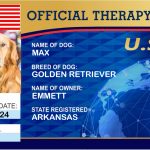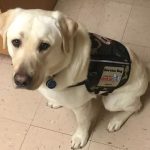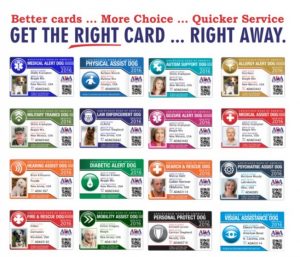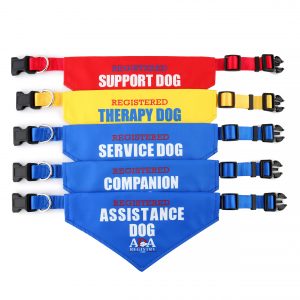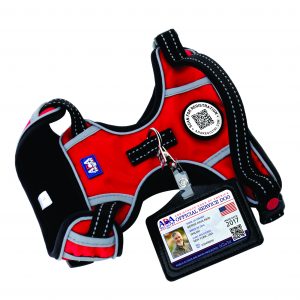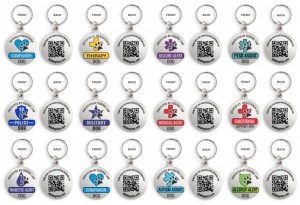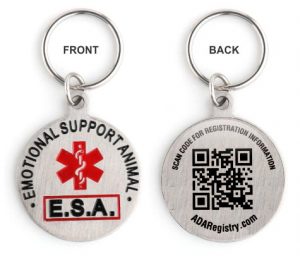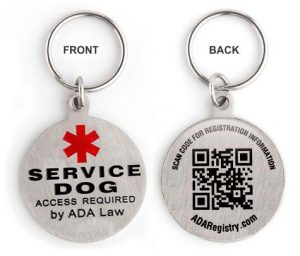Nonprofit Soldier’s Best Friend
December 28, 2020
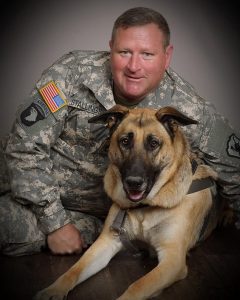
Staff Sgt. Terry Stallings served in the Army for 23 years. He was stationed across the globe, including posts in Iraq, Balad, Kuwait, Desert Storm, Mexico, Central America, Alaska, Portugal and Germany.
After six combat deployments overseas, he returned home and was diagnosed with post- traumatic stress disorder.
Veterans often rely on medications, therapy, sports and other treatment options for PTSD relief. Stallings looked toward companionship.
“He’s basically my battle buddy,” Stallings said. “Wherever I go, he follows me. If I’m laying down, he lays down at the foot of our bed. If I’m in the living room, he lays down next to my chair. He’s always ready to help me.”
“He” is Stallings’ service dog, a 135-pound Anatolian shepherd named Koda.
“Koda’s learned when I’m having nightmares, he’ll come up and he’ll comfort me,” Stallings said. “He’ll put his wet, cold nose on me at night when I’m sleeping and wake me up because he knows I’m having a bad dream or an episode or something like that.”
“So he’s always there.”
Stallings and his wife, Debbie, picked up two Anatolian brothers with the intention of eventually training one or both as service dogs.
“I thought it’d be nice to have one. We actually weren’t even sure what a service dog would do for us,” Stallings said, “but we decided to look around and do some research.”
The Mesa residents turned to Soldier’s Best Friend,an Arizona nonprofit that trains dogs to work with veterans with PTSD – or a combat-related traumatic brain injury – as service dogs. The organization either pairs the veteran with a dog adopted from a local shelter, or they train a dog already owned by the veteran.
“One thing we did notice was everywhere we looked and all the inquiries that we did, everything was leading us towards Soldier’s Best Friend as being the best (organization) out of all of them,” Stallings said.
Soldier’s Best Friend has been a nonprofit since 2001. Its program comes at no cost to the veteran. It has nearly 40 contributors – including volunteers and organizations – and is entirely funded through donations, grants and fundraisers.
“We go in, and we give back,” Stallings said. “Because it’s a nonprofit, they have to do fundraisers and stuff. And because (Koda’s) so well-trained, we don’t have a problem going out and helping or being the poster dog.”
Soldier’s Best Friend has helped hundreds of veterans, with nearly 300 dog-veterans teams that have graduated, according to its website. The group has five locations: Phoenix, Tucson, Prescott, Sierra Vista and Flagstaff.
Its staff is made up of war veterans, practicing PTSD therapists, professional service dog trainers, veterinarians and nonprofit professionals.
Not all dogs at Soldier’s Best Friend start out like Koda, already belonging to the veteran; many come from local shelters around the Valley.
Sarah Eccleton, the organization’s dog adoption and placement coordinator, has been working with dogs since she was a child.
“I actually would go and watch my mom do dog training classes, and by age 6, I was done watching,” she said. “We’ve got pictures of me, 6 years old with my first toy poodle, training it.”
Eccleton said because of her closeness with breeders, competing and training her own dogs, and understanding ATC (“authority to compete” referring to the guidelines to compete in the international dog show Crufts), she was prepared to deal with dogs of every personality type.
“I did a lot of behavioral training at a boarding facility that took all the reject (puppies) with temperament issues from everybody,” Eccleton said. “So that’s where I learned a lot of aggression and behavior training. That’s what made me a candidate for this position.”
Her current job is to understand the veteran’s lifestyle and needs and pair them with a dog to complete the training program at Soldier’s Best Friend.
“I get an understanding of what they’re capable of training and working with,” Eccleton said, “how active they are, how much grooming they’re willing to do, what needs they have for their TBI (traumatic brain injury) or PTSD.”
After her conversation with the veteran, she reaches out to shelters and describes what sort of dog she wants. Eccleton said she relies heavily on the kennel aides at shelters to help with the pairing process.
“They are hands-on with all their dogs, so they have a better insight of, ‘Well, I think this will fit,’” Eccleton said.
Shelters provide five to 10 dogs for Eccleton.
“I evaluate them for temperament, good with people, good with dogs, good with other animals, trainability and if they’re food or toy motivated,” Eccleton said.
Soldier’s Best Friend uses B.A.R.C. – Behavior Assessment Reactivity Checklist – to evaluate a dog’s interactions with humans and their reactions to such things as people in public or sounds. The nonprofit has rescued more than 165 dogs, according to its website.
The adopted pup moves into the foster period, which typically takes a few weeks to a month. The adopted dog is fostered by volunteers, and they work with a trainer from Soldier’s Best Friend to break some of their shelter habits, teach them basic skills and prepare them to enter into the training program alongside their veteran.
“That’s one of the requirements at Soldier’s Best Friend,” Stallings said. “If (Soldier’s Best Friend) provide a dog … they require that the dog has a certain amount of skills already trained in him so that they can see if the dog is trainable.”
Whether a dog goes through the adoption process or is brought in by a veteran, the dog must know how to perform basic commands, Stallings said. If the dog can sit, shake and/or lay down, staff members know the dog is teachable.
All dogs are spayed, neutered and vaccinated, and they have received all recommended preventative medications before placement, according to the organization’s website.
Veterans who are paired with rescue dogs will not be charged for veterinary services and most supplies during the training process, the organization says, and veterans who own dogs will get veterinary services at a reduced rate during training.
Each veteran and dog go through a six- to nine-month training program. The program’s teaching is aligned with the Canine Good Citizen training – a 10-skill program that teaches dogs the basics of manners and obedience – and requires a minimum of three personal service tasks.
The veteran also is given a written test that covers proper care and training techniques for their dogs.
Allison Walker, a lead trainer at the nonprofit, said they focus on training the veterans – the handler – how to train the dog themselves.
“Every trainer is assigned teams, and the teams do one group lesson and one individual lesson every week,” Walker said. “Every trainer is taking their teams through from day one through graduation.”
The primary focus of Soldier’s Best Friend is to train the dogs to be service animals, but the program is equally as rigorous for the veterans. Because of their PTSD symptoms, everyday tasks such as going to a store or attending a crowded event can become nearly impossible for some.
“We tell them that this program is going to push their boundaries and test their limits,” Walker said, “because although we don’t want to overwhelm anyone, we want them when they are in the real world to know how to respond to things.”
Stallings said the training program changed his mind about repetitiveness and perseverance. Because of his military background, he liked to give a command and see it performed right away. He also was quick to get frustrated and react.
“There’s a saying in the program: It only takes a couple of weeks to train a dog; it takes six to nine months to train the veteran,” Stallings said. “The dog will usually get it before the veteran gets it. You learn patience really quick, which is a skill that when you go back into the civilian world, it’s really hard to have patience.”
Anatolian shepherds, like Koda, are livestock guard dogs and trackers – dogs that can detect, recognize and follow a scent. Stallings said this trait is most beneficial for him when he’s in crowded places and begins to feel anxious.
“If I’m looking in one aisle and she’s in another, and I kind of feel like I’m getting amped up – my PTSD or whatever – and I need to get back to my wife, I can tell Koda, ‘Find Mom.’ And what he’ll do is he’ll immediately go into track mode, and he’ll take me back to her,” Stallings said.
The nonprofit’s main goal is to train each dog to fit the veterans’ unique and specific needs.
“Every dog is a little bit different, and every veteran needs something different from their dog,” Walker said. “We do a lot of talking and deciding what tasks the veteran is going to teach the dog because the task work is so personal.”
Koda has graduated from service dog training, but he and Stallings now attend advanced training classes at the nonprofit. The tasks mastered at this training level have made Stallings feel more at ease. Koda is his second set of eyes.
“I’ve always worried about people being behind me where I can’t see,” Stallings said, ”so I taught him to watch my back.
“He would sit on my right side and look behind me. He’ll actually nudge me, letting me know there are people behind me, that he can see them and it’s OK.”
Koda is there to lend a helping paw when Stallings needs help up.
“If I was sitting on the floor or sitting in a chair and I needed him,” Stallings said, “he’ll come to me and I’ll tell him to brace, and then he locks his front legs up. Between his shoulder blades, I can apply all my body weight on him and stand up basically like a cane.”
Koda also “has learned to turn on light switches, to open up all the doors in the house and close them,” Stallings said.
At the beginning of the program, however, Stallings was skeptical.
“I know when we first started it, I was like, ‘There’s no way this is going to work,’” he said.
He could tell that Koda did not understand why he was training or going through such repetitive motions, but it didn’t take long to see a change in himself and his dog.
“All of a sudden, the light would kick on, and he’d understand,” Stallings said. “It’s kind of cool to see him get it. It’s almost like he’s smiling, he’s figured it out. ‘I know why I’m doing this.’”
Walker said she, too, can see a dog’s mentality change throughout the training.
“One day they come in, and they realize they are no longer just a pet,” Walker said.
But the veterans also go through a big change as well.
“They see all of a sudden how their life is opened up,” Walker said, “because they have a service dog, and they see now that they are going to be able to do things that they thought they never would be able to do again.”
Eccleton compares the veterans to the newly adopted dogs: timid and anxious when they first enter the program.
“When you’re working with a fearful dog, you’ve got to have them be exposed to that fear, right? Because you can’t conquer the fear if you just avoid it,” she said. “Once you conquer it, and then you see, ‘OK, I survived that.’ That’s a reward in itself, so I think that’s the same kind of therapeutic effect for our veterans.”
Walker said she began at Soldier’s Best Friend with the intention of learning to train and educate, but seeing the difference a service dog can make on a veteran is the most rewarding part.
“Being able to help veterans achieve that sense of independence again,” Walker said, “especially helping them communicate with their dogs more effectively and connect with their dogs … because they do come to trust each other.”
Stallings said Koda’s brother Kacey has been able to pick up on some of the skills Koda has learned. But they still get to spend their time together playing and being normal pets.
“One of the things I noticed a lot is when he’s not suited up, he’s just a dog,” Stallings said. “I watch him play in the backyard and when the mailman comes … he’s barking out of the window, ‘I see you, I see you,’ but as soon as I put the vest on him, it’s like flipping a light switch. It’s like, ‘OK, I’m working now.’”
Stallings said Soldier’s Best Friend only strengthened the bond between him and Koda, and now they’re more than just pet and owner.
“He acts like he has a purpose,” Stallings said.
Check Out Our Store


